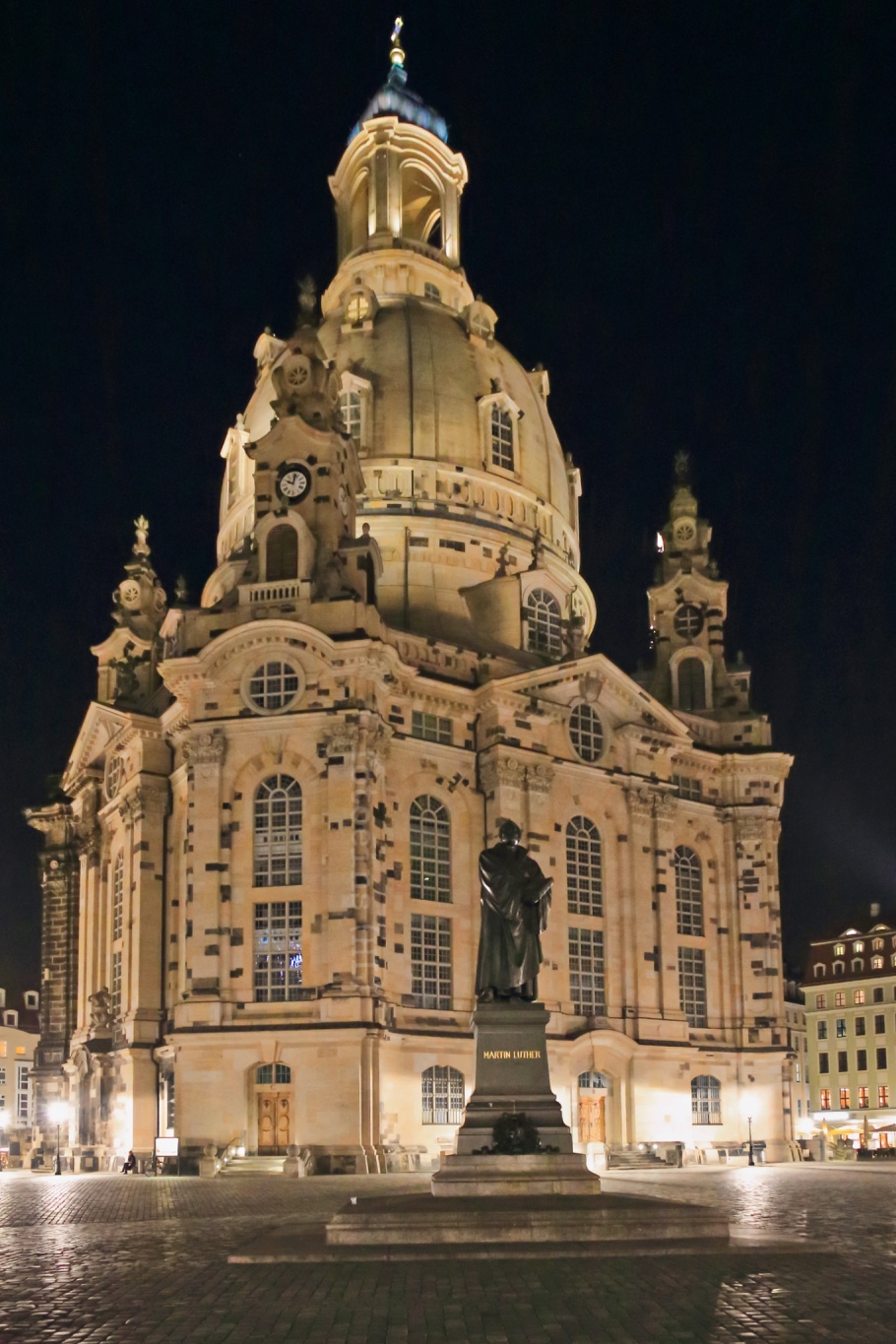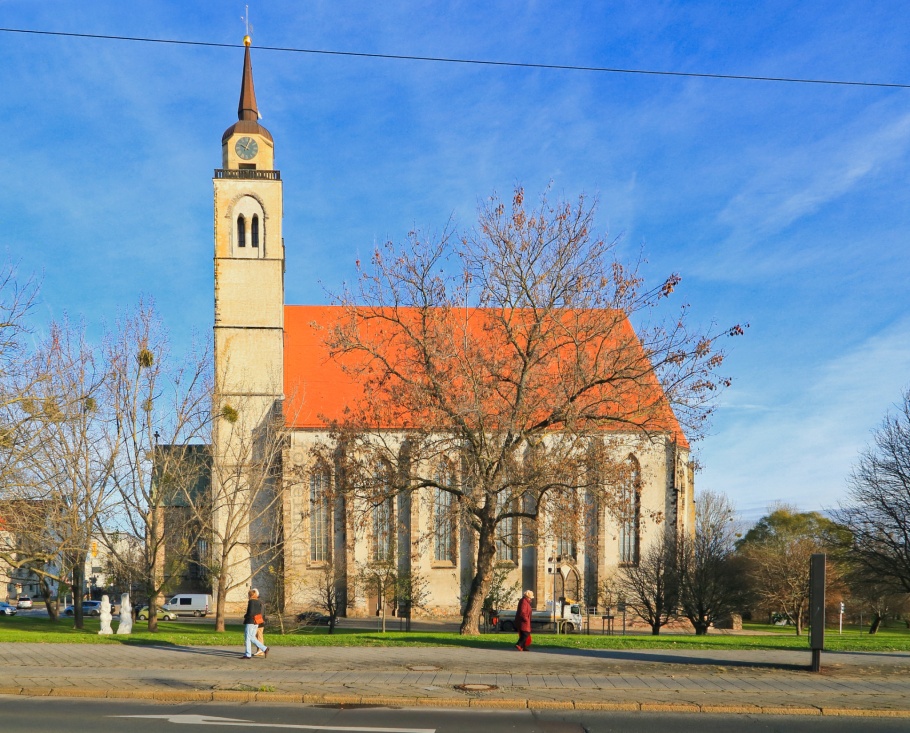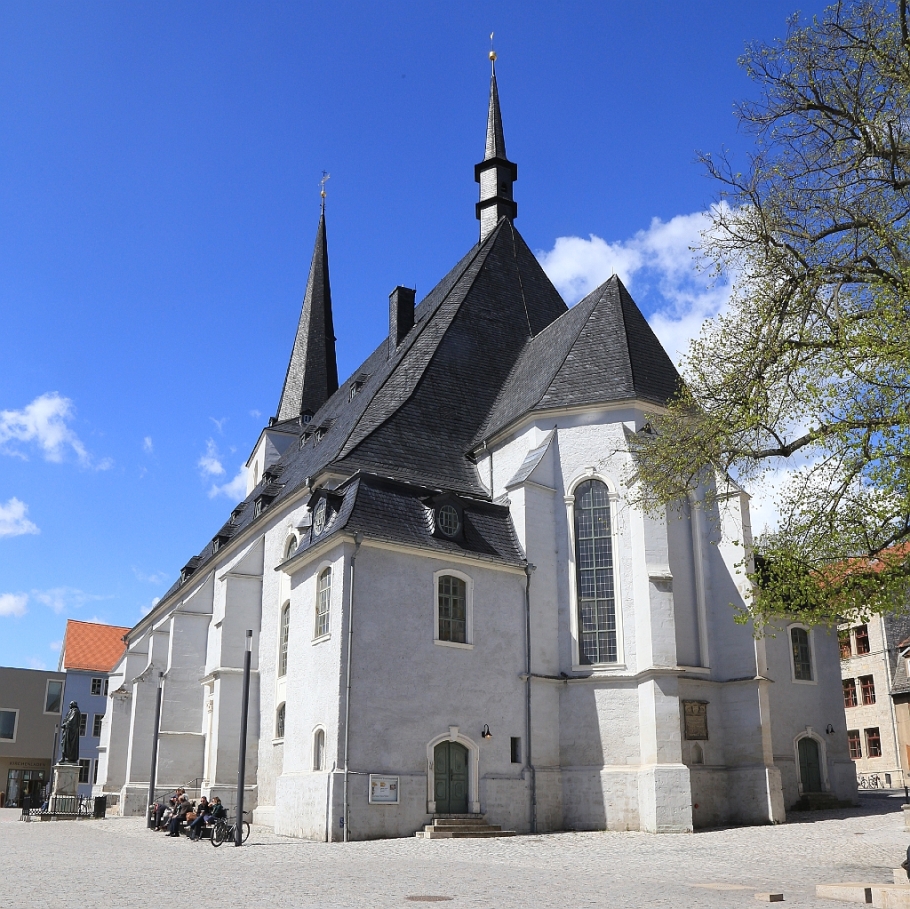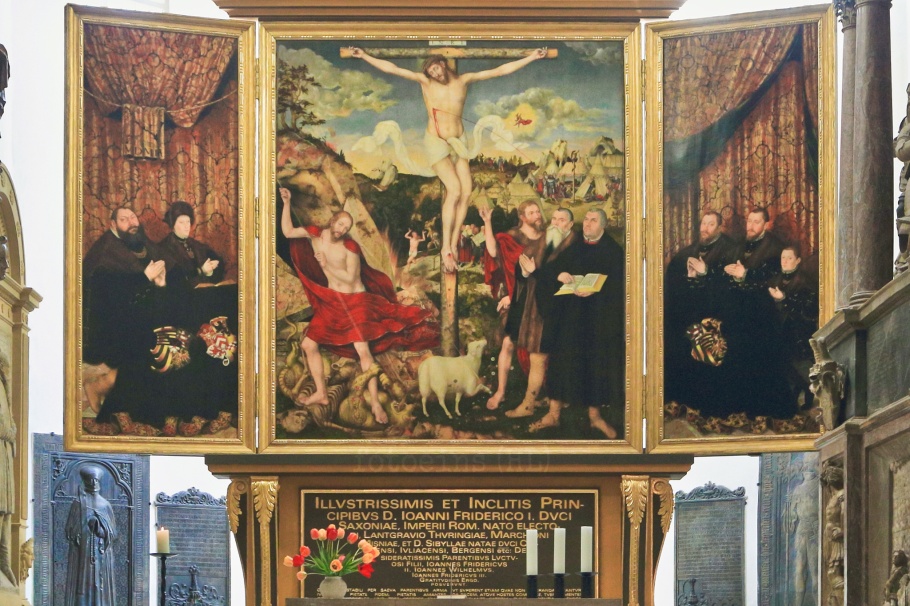Martin Luther: tracing his steps in 16 German cities
Above/featured: “Luther war hier. (Luther was here.)” Eisleben, Germany. Photo, 27 Oct 2016.
In pre-teen years, I attended a Catholic elementary school by weekday, and a missions-oriented Protestant church by weekend. I already had multiple questions running around my pre-scientist brain, like electrons appearing and dissipating in a fuzzy halo. When various disparate elements began to settle with few satisfying answers, I left behind the churches and their respective religions. But one thing that’s remained is my love of history. History has never been boring, because I carry the past (as offspring of immigrants), and I’m determined to bring history’s lessons into the present.
Even in youth, I had to ask: why was one set of churches called “Protestant”? What was under protest? How did one man help spark a movement that would help merge and create a version of a language that continues today, that would bring accessible means to literacy for the public, and that would begin to change rule by religion to rule by law?
Martin Luther: Luder’ name at birth
From his birth in Eisleben; to formative years in Mansfeld, Magdeburg, and Erfurt; to the bulk of his working and teaching years in Wittenberg; to his death in Eisleben, Martin Luther set upon a course that helped change language, education, culture, religion, and governance. In many ways, Luther had much to thank Jan Hus for the latter’s efforts to reform the Catholic Church in Bohemia one hundred years earlier.
Every year on the 31st of October, a number of cities, regions, and federal states in Germany mark an important event in this movement. It’s widely understood Martin Luther walked up to the Castle Church in Wittenberg and pinned his 95 Theses to the church doors on 31 October 1517. Even if direct evidence Luther actually posted papers to the doors is debatable, what’s not is that 2017 marks the 500th anniversary of the Reformation in Germany.

The illuminated Luther memorial stands tall in front of Wittenberg’s town hall at Market Square. As UNESCO World Heritage Site, the town hosts 4 sites: Luther House, Melanchthon House, St. Mary’s Town Church, and the Castle Church. 2017 is the 500th anniversary of Luther’s Reformation in Germany. Various German federal states, regions, and cities will mark the quincentenary throughout the year. Photo at Wittenberg Marktplatz on 30 Oct 2016.
16 places in Germany
Luther influenced people and cities throughout what is now present-day Germany. In a non-exhaustive list, here are 16 cities (in alphabetical order) where he left his mark: 6 are in the federal state of Saxony-Anhalt, 3 in Thuringia, 2 in Saxony, 2 in Rhineland-Palatinate, 2 in Bavaria, and 1 in the state of Baden-Württemberg.
- Augsburg (Bavaria)
- Dessau (Saxony-Anhalt)
- Dresden (Saxony)
- Eisenach (Thuringia)
- Eisleben (Saxony-Anhalt)
- Erfurt (Thuringia)
- Halle an der Saale (Saxony-Anhalt)
- Heidelberg (Baden-Württemberg)
- Leipzig (Saxony)
- Magdeburg (Saxony-Anhalt)
- Mansfeld (Saxony-Anhalt)
- Mittenwald (Bavaria)
- Speyer (Rhineland-Palatinate)
- Weimar (Thuringia)
- Wittenberg (Saxony-Anhalt)
- Worms (Rhineland-Palatinate)
Every city listed is accessible with German national rail (Deutsche Bahn).
1. Augsburg (Bavaria)
In 1518, Martin Luther was called to Augsburg to answer Cardinal Cajetan’s charge of heresy. Cajetan ordered Luther to withdraw statements challenging the morality of the practice of indulgences and questioning the supreme authority of the Pope. With no satisfactory conclusion for either side, Luther posted in defiance at the cathedral’s portal a notice opposing Rome’s heresy trial against him. With Cajetan’s subsequent orders to arrest Luther looming large, Luther managed to escape Augsburg. In the Augsburg Confessions (Confessio Augustana), Phillip Melanchthon set down into print the underlying principles of the Reformation as “confessions” in 1530. The document was delivered to and read by Holy Roman Emperor Charles V at the Diet of Augsburg. In 1555, the Peace of Augsburg recognized the Confessions and allowed local rulers the authority to decide what religion their subjects could follow (cuius regio, eius religio). Today, a plaque near the cathedral commemorates Luther’s act of dissent in 1518.
• At the Domportal: REVOCA! Cajetan demanded of Luther in 1518; Luther said “no.”
• Augsburg: Fugger, Luther, & water in Germany’s 3rd oldest city

Photo at Domplatz on 10 Mar 2017.
2. Dessau (Saxony-Anhalt)
Situated only 30 kilometres (20 miles) west from Wittenberg, Martin Luther visited Dessau regularly and preached at St. Mary’s Church (Marienkirche). Built in 1508 and finished in 1554, the castle and town church of St. Mary’s was constructed on the site of a former Romanesque church. In 1534, the city’s authorities declared the city as Lutheran, and in the same year on the Thursday before Easter, Luther offered Communion to the community, providing the town another push towards the Reformation. This building is no longer a church and is used as event space.

Dessau Marienkirche (St. Mary’s). Photo on 28 Oct 2016.
3. Dresden (Saxony)
Standing in the square in front of Dresden’s landmark Frauenkirche is a late 19th-century memorial to Luther’s visit to the city in 1516 and 1517. The memorial statue was destroyed along with the church in Allied air raids of 1945. Post-reunification meant repair funding and work, and the statue was restored and reinstalled in conjunction with the unveiling of the Frauenkirche in 2005.

Martin Luther memorial in front of the Frauenkirche, at Neumarkt – 22 Apr 2015.
4. Eisenach (Thuringia)
After being called to the Imperial Diet (parliament) of Worms in 1521 to answer charges of heresy, Luther departed with his life under threat. His benefactor Frederick the Wise of Saxony arranged to have Luther “kidnapped” and brought to Wartburg Castle in Eisenach to ensure Luther’s safety. In Wartburg, Luther hid as “Junker Jörg” (Knight George), and proceeded to translate the New Testament from Greek into German. From a variety of dialects at the time, he created a common simplified version of German to ensure accessibility to as many people as possible which would improve literacy at large. The Wartburg Castle has been a UNESCO World Heritage Site since 1999.

Wartburg Castle in Eisenach – 25 Apr 2015.
5. Eisleben (Saxony-Anhalt)
Eisleben is the city where Martin Luther was born in 1483 and where he died in 1546. However, most of his youth- and adult-years were spent in Mansfeld and Wittenberg, respectively; see below. The Luther Birth- and Death Houses are part of the inscription as UNESCO World Heritage Site since 1996. Below is a picture from inside the Peter-Pauli-Kirche (Peter and Paul Church) where Luther was baptized the day after he was born.
• Martin Luther’s Birth & Death Sites
• Fotoeins Friday: where Martin Luther was baptized in Eisleben

The font in which Martin Luther was baptized on 11 Nov 1483 appears at centre-left. Next to the famous font, the modern baptistry with pumps underneath to simulate the constant flow of water is a focal point from which circular waves emanate. Underneath the Luther Rose on the ceiling lies a second focal point (at lower centre) representing the impact of Luther/Protestantism. The church here was built between 1447 and 1513, although a previous church dedicated to Peter had already been present by the end of the 13th-century. Photo on 26 Oct 2016.
6. Erfurt (Thuringia)
Erfurt is the city where Luther enrolled at the University of Erfurt in 1501 to successfully complete the Baccaleureat and Master’s degrees in arts and humanities, and where he changed his life and entered the Augustine monastery in 1505 at the age of 22 to become a monk. In 1521, he introduced to the city’s citizenry principles of what would become the Reformation; he would subsequently be called to the Diet of Worms to answer to the charge of heresy. After successfully hiding out in Eisenach’s Wartburg Castle (see above), he returned to Erfurt in 1522 and gave a sermon at Kaufmannskirche (Merchants’ Church). Luther is honoured with a memorial statue in front of the church, which was built in 1248 as Romanesque church and rebuilt and reconsecrated in the Gothic style in 1368. The parents of Johann Sebastian Bach were married at this church in 1668.
• Erfurt: Martin Luther’s start at the Augustine Monastery

Photo on 26 Apr 2015.
7. Halle an der Saale (Saxony-Anhalt)
Halle was the home of Luther’s great rival, Cardinal Albrecht, Archbishop of Magdeburg and Mainz, who was the highest-ranking dignitary after the Pope in the Holy Roman Empire. Albrecht would have been the recipient of Luther’s letter with arguments against Catholic dogma and challenges against excess by Albrecht and the Church. Albrecht would eventually be forced out of Halle in 1541. After Luther’s death in Eisleben in 1546, the subsequent funeral procession on foot to Wittenberg stopped in Halle where molds of his death mask and hands were made. These relics now reside in the Marktkirche St. Marien (St. Mary’s Market Church). Across from the church is Germany’s oldest and likely largest Protestant library, the Marienbibliothek, with several Luther Bibles.
• Halle highlights in the Händelstadt

The four towers at left (Gothic) and centre (Romanesque) are part of the Marktkirche St. Marien (St. Mary’s Market Church, built 1530-1554). Martin Luther’s death mask and hands (apparent molds) are located in the church. At right is the free-standing Gothic Roter Turm (Red Tower, built 1418-1506) with clock and bells. Photo from Marktplatz/Ratshof on 3 Nov 2016.

In February 1546, Martin Luther died in Eisleben during a trip to the city of his birth to mediate a dispute among members of a local family. Upon request from Luther friend and former student, Justus Jonas, artist Lukas Furtenagel created a plaster mask of Luther’s face and hands at his deathbed. A funeral procession on foot departed for Wittenberg by way of Halle. In Halle, Luther’s body was kept at the Marktkirche (Market Church) for the day. Justus Jonas was the first Protestant pastor at the church, and most likely the reason why the Halle church came into possession of the death relics. While the mask and hands have gone through several versions (e.g., mask with closed-, open-eyelids), visitors today can view them both in a small room inside the church. Photo from Marktkirche St. Marien on 1 Nov 2016.
8. Heidelberg (Baden-Württemberg)
The Universitätsplatz (University Square) in Heidelberg is over the foundation walls of the former Augustinian monastery. To commemorate Luther’s visit to the monastery and debate (Disputation) in 1518, a memorial plaque was installed at Universitätsplatz in 1983. The plaque reads:
Martin Luther (1483-1546): zum Gedenken an seinen Aufenthalt im Kloster der Augustiner und an seine Heidelberger Disputation am 26. April 1518. Im Lutherjahr 1983.In commemoration of his Heidelberg visit at the Augustinian monastery and debate on the 26th of April 1518. In Luther year 1983 (500th anniversary of his birth).
• My Heidelberg: 1 of 38 Highlights from Home.

1983 plaque commemorating Martin Luther’s visit to the Augustinian monastery in Heidelberg and his Disputation on 26 April 1518. Photo on 14 Mar 2017.
9. Leipzig (Saxony)
The Leipzig Disputation in 1519 pitted Luther, Philipp Melanchthon, and Andreas Bodenstein (Karlstadt) against Johannes Eck from Ingolstadt. During the debates, the Protestant reformers cast doubt on the absolute doctrinal authority of the Pope. The Reformation movement bore fruit in the city with the first Lutheran sermons in 1522. Luther returned to Leipzig in 1539 with a visit to St. Thomas Church after the city converted officially to the Reformation. This same church is best known for Johann Sebastian Bach; he was the church’s Kapellmeister (music director) from 1723 until his death in 1750, and his grave is near the church’s main altar.

With a presence dating back to the early 13th-century, the St. Thomas Church (Thomaskirche) is presently a Lutheran church in the city of Leipzig, Germany. The church is the final resting place for composer Johann Sebastian Bach, in the same venue where he was choir director from 1723 to 1750. Martin Luther preached here about the teachings of the Reformation in 1539. Photo made on 3 Dec 2014.
10. Magdeburg (Saxony-Anhalt)
In 1497 at the age of 14, Luther left Mansfeld for further education in Magdeburg for about a year, before he moved onto Eisenach and Erfurt. Luther would subsequently visit Magdeburg a number of times later in life. Most notably in 1524, he visited the Johanniskirche (St. John’s Church) and his sermon helped convince most of the city’s council to convert to the Reformation. A monument to Luther by Emil Hundrieser in 1886 now stands in front of St. John’s Church.
• Magdeburg, the city of 2 Ottos

As a teenager, Martin Luther spent a year at a boarding school in Magdeburg. He returned in 1524 to give two sermons, one here at St. John’s Church, which inspired most of the city’s churches to reform to the new Protestant movement within days and weeks. Magdeburg would become a staunch supporter of Protestantism for which the city would pay dearly in the 30 Years’ War. Photo on 3 Dec 2015.
11. Mansfeld (Saxony-Anhalt)
Shortly after Martin was born in 1483, his parents, Hans and Margarete Luder, moved the household from Eisleben to nearby Mansfeld for better economic opportunities; historically, the surrounding area was dotted with many mines for ore and minerals. With steady income from mining and subsequent mining operations, the Luder family lived comfortably, and Martin’s parents lived in Mansfeld for the rest of their lives. Martin grew up in Mansfeld until the age of 14. In 1497, Martin departed for Magdeburg and Eisenach to further his education. Martin would sign documents and letters with the surname evolving from Luder to Eleutherius to Luther. The restored family house and the modern museum across the street provide an account for life in the late-15th and early-16th century in the Mansfeld-Südharz region.
• Mansfeld: Martin Luther’s childhood home
• Fotoeins Friday: Luther’s parents house in Mansfeld

West view of the town from Schloss Mansfeld. Mansfeld is 10 km northwest from the town of Eisleben in the German state of Saxony Anhalt. Photo on 27 Oct 2016.
12. Mittenwald (Bavaria)
After being ordained as a priest in 1507, Martin Luther continued his (doctoral) studies in Theology at the University of Erfurt. He and a fellow monk were called to Rome in 1510 to represent the Augustinian order. His outbound journey from Erfurt took him west through Nuremberg, Ulm, Lindau, and Milan. The return journey to Erfurt took him on an eastern route through Verona, Innsbruck, the Isar river valley via Mittenwald, then Augsburg, Nuremberg, and beyond. There isn’t a lot of physical evidence of his stay at the Pilgerhaus (Pilgrim House) in Mittenwald in March 1511, but that didn’t stop the Pilgerhaus from installing signage nor the local evangelical Protestant church (Evangelisch-Lutherische Dreifaltigkeitskirche Mittenwald) from constructing a stone memorial in 1983 (on the 500th anniversary year of his birth).

Luther memorial in front of Mittenwald’s Protestant church. Photo on 28 Feb 2017.
13. Speyer (Rhineland-Palatinate)
Completed in 1904, the Gedächtniskirche (Memorial Church) acknowledges the reformers’ protests against the reinstatement of the absolute authority of the Catholic Church at the Imperial Diet (royal parliament) in Speyer in 1529. Representatives of self-declared evangelical or “reform” states within the Holy Roman Empire had arrived in Speyer to convene the imperial parliament (Diet) to protest the continuing intransigence of the Pope to allow an alternative to Catholicism. In hindsight, a way to break papal power structures would prove politically useful to regional rulers who wished to rally people around the cause of “local rule”, rather than rule from a very distant Rome. After the official declaration of protest, followers of the Reform or Luther movement would be known as “Protestants.”

The Memorial Church of the Protestation (Gedächtniskirche der Protestation) and the Luther memorial at the front door both commemorate the protests at the 1529 Diet of Speyer. Photo on 21 Nov 2015.
14. Weimar (Thuringia)
Weimar’s St. Peter and Paul parish church (also called the Herder Church) contains a pulpit that was used by Luther between 1518 and 1540. The church also features the 1555 altar triptych. The triptych was painted by Lucas Cranach the Senior and Junior, both of whom were Luther’s contemporaries. The altar piece is an important testament to Reformation history for Weimar and present-day Thuringia. The Herder Church is part of the “Classic Weimar” inscription as UNESCO World Heritage Site since 1998.
• Weimar Classicism: Cranach Altar in the City Church

At Herderplatz, the Town Church of St. Peter and Paul dates back to 1500, although an original church on this site goes back to about 1245. With its alternative name as the Herder Church after the Johann Herder, the church is home to the triptych painting begun in 1552 by Cranach the Elder and completed by his son (Cranach the Junior). This church is a part of the “Classic Weimar” inscription as UNESCO World Heritage Site since 1998. Photo on 30 Apr 2015.

The Cranach Altar is a triptych depicting Christ’s crucification, and is an important artistic and historic piece representative of the Reformation period; there’s a Latin inscription on the reconstucted Predalla. The four figures at the foot of the cross (viewer left to right) are a resurrected Christ, St. John the Baptist, Cranach the Younger, and Martin Luther. This church altar was completed in 1555 by Lucas Cranach the Younger, and installed in the Church of St. Peter and St. Paul in 1557. 2015 was the 500th birthday of Cranach the Younger. Photo on 30 Apr 2015.
15. Wittenberg (Saxony-Anhalt)
Wittenberg is where Martin Luther spent a large part of his life and career, happily married to former nun Katharina von Bora who would be his business and managing partner. Four sites make up the town’s inscription as UNESCO World Heritage Site since 1996: St. Mary’s Town Church, Castle Church, Luther House, and Melanchthon House. Wittenberg was the centre of attention for the Reformation quincentenary in 2017.
• Castle Church (Schlosskirche)
• St. Mary’s Town and Parish Church (Stadt- und Pfarrenkirche St. Marien)
• More historical highlights in Wittenberg

The Stadtkirche St. Marien (St. Mary’s Town Church, at upper-left) and the Schlosskirche (All Saints’ Church or Castle Church, at lower-right) are 2 of 4 locations which make up the UNESCO World Heritage Site in Wittenberg. The graves for Martin Luther and Philipp Melanchthon reside in All Saints’ Church; Luther gave sermons in the Town Church. Photo on 29 Oct 2016.

Katharina von Bora: born 1499, died 1552; former nun, Martin Luther’s business and managing partner; his life partner, wife, and mother to 6 children. Unveiled on the 447th anniversary of her death in 1999, this memorial statue by Nina Koch resides in the central courtyard of the Luther House in Lutherstadt Wittenberg, Germany. The Luther House is where he lived most of his adult life and is 1 of 4 sites in the town as UNESCO World Heritage Site (since 1996). This 2017 year is the 500th anniversary of Luther’s Reformation. Photo on 30 Oct 2016.
16. Worms (Rhineland-Palatinate)
Martin Luther was called to the Imperial Diet (parliament) of Worms in 1521 to answer charges of heresy. He went to Worms to defend himself, but he would have been wary, no doubt thinking about what happened to Bohemian reformer Jan Hus in 1415. Luther denied all charges and stuck to his arguments against excess and absolute authority of the Pope and the Catholic Church. Designed by Ernst Rietschel and unveiled in 1868, the Luther Memorial in Worms is the world’s largest Reformation monument which also includes other important persons of the Reformation.
• Luther on trial in 1521 at the Diet of Worms
• The world’s largest Reformation monument

Better described as the Reformation Memorial, this is the world’s largest Luther memorial and is located near the location in Worms where Luther was called to defend himself against charges of heresy when the imperial parliament or Diet convened here in 1521. Photo on 22 Nov 2015.
More
• Martin Luther timeline (Luther Country)
• Luther 2017
The map below of “Luther Country” in the German federal states of Saxony-Anhalt and Thuringia shows places where Martin Luther left his mark; nine cities marked with orange squares are included in the list above.

Luther Country, in Saxony-Anhalt and Thuringia.
This post appears on Fotoeins Fotografie at fotoeins DOT com as http://wp.me/p1BIdT-9aV. I made all photos with a Canon EOS6D mark1 on visits between December 2014 and March 2017. Leipzig Tourismus und Marketing supported my visit in December 2014. Germany Tourism, Visit Thuringia, and TMG Saxony supported visits to Erfurt, Weimar, Dresden in April 2015. In December 2015, Romantic Cities (Rheinland-Pfalz) supported visits to Speyer and Worms, and Magdeburg MMKT supported my visit. IMG Sachsen-Anhalt supported my October 2016 visit to the German federal state of Saxony-Anhalt with additional assistance from the cities of Eisleben-Mansfeld, Dessau-Rosslau, Wittenberg, and Halle. Augsburg Tourismus supported my visit in March 2017.
5 Responses to “Martin Luther: tracing his steps in 16 German cities”
[…] in Prague • Jiří z Poděbrad (George of Poděbrady) • Precedes Martin Luther’s Reformation by 100 years • World’s largest Reformation monument in Worms, Germany, […]
LikeLike
[…] Martin Luther’s traces in 16 cities & towns throughout Germany (link) […]
LikeLike
[…] The rise of Jiří z Poděbrad (George of Poděbrady). • The Hussite movement precedes Luther’s Reformation by about 100 years. • 2nd Defenestration of Prague in 1618, triggered international […]
LikeLike
Wonderful, and thanks alot for your works.
LikeLike
Dr. Kim, thanks for reading, and for your kind comment.
LikeLiked by 1 person